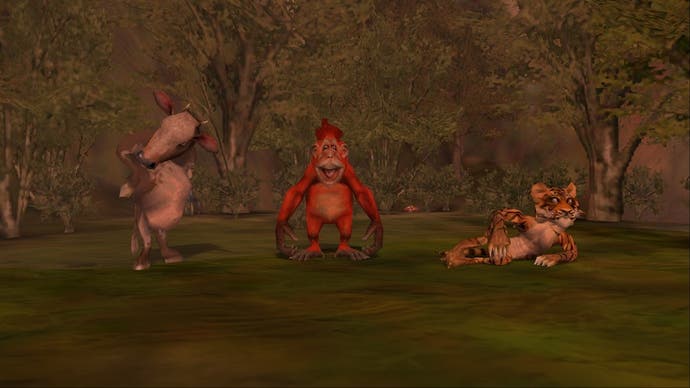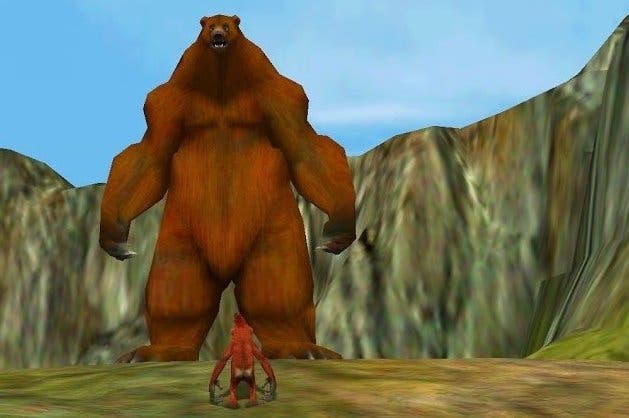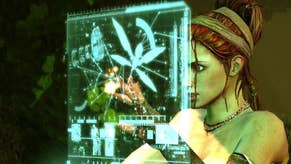Black & White combined the sublime with the stupid
Where the falling angel meets the rising ape.
I always pick the ape. I'd like to say I do this for some meaningful reason. But the truth is I do it because monkeys are funny. Not as funny as penguins. Penguins are slapstick incarnate. But you can't play as a penguin in Black & White. Note to all game developers: more penguins please.
Yet as I've returned to Black & White over the years, I've realised the ape is the ideal creature for a god in its universe. Apes are one evolutionary step away from a higher intelligence, capable of using their minds in ways beyond what nature has instilled in them. This can be productive, such as using tools, or something destructive, such as murder. In this way the ape a perfect embodiment of a human playing god; a creature that sends probes to distant worlds while slowly microwaving its own, that uses a smartphone to take pictures of its genitals, equal parts divine and asinine.
But the ape represents more than that. It's a microcosm of Black & White itself because the game is also one step away from a higher intelligence. Even 14 years on, it still does things that no game has come close to matching since. Within its code are glimpses of a path games ultimately never ventured down. But its pursuit of the revolutionary also includes moments of monumental stupidity, revealing glimpses of another path that its own creator seems unable to prevent himself pursuing.

Despite this ambiguity, something which Black & White rather archaically ignores, one thing is certain; Black & White is the goddest of god games. This is a game in which you are born by prayer and thrive on belief, where praise feeds miracles and the limits of your influence are defined by the faith of your flock. You can split a boulder in two with a tap of your finger, and burn down an entire village with a sweep of your hand. It's the ultimate power fantasy, over and above the most testosterone-fuelled FPS.
It wasn't always this way. Initial prototypes of Black & White had players assume the role of wizards competing for supremacy over a chain of islands. You can still see bits of this in the final version. Several of the miracles have a distinct sword and sorcery flavour about them, while the temples could easily be mistaken for a wizard's tower.
At some point, the wizards ditched their robes and staffs for cassocks and crosiers, as the game looked to the heavens for inspiration rather than staring at dusty grimoires. In his Gamasutra post-mortem of Black & White, Molyneux states that he refused to let anything get in the way of his godly vision. He wanted lands that seemed real and worth presiding over as the Almighty, that you could view from the heavens or inspect every detail of. He also wanted all interaction with the game to feel natural and direct, with no artificial UI acting as a barrier between god and subjects.
The merits of this approach are still obvious today. Black & White remains remarkably attractive, its soft lighting and liberal use of bright colours outweighing the lumpy models and world geometry. It's also startlingly clean, with no icons obscuring its crystalline waters or bustling villages. The cost of this approach has lessened over time too. The camera controls and miracle gestures are much less awkward to perform with a modern mouse.
But within Black & White's code is a technological achievement that goes way beyond the familiar push for visual excellence. It contains one of the only examples of machine learning in a mainstream video game.

The concept of an AI that learns as the game goes on is something that games have barely explored. Most game AI have either hard-coded behaviours which remain fixed for the entire game, or multiple behaviour states that they can cycle between as the situation arises, such as the guards in Thief. Yet no matter how many times you get spotted by a guard in Thief, they'll never learn to look for you in the shadows. And while you might encounter AI that's more aggressive or more perceptive if you alter the difficulty setting, their behaviour loops are always closed.
Games adhere to this model for various reasons. It's what most AI designers know. It's fairly easy to implement and create variations upon. Many games need the AI to be somewhat predictable so the player can learn how to overcome it. Even Black & White uses this traditional framework for its villagers. They might possess a range of wants and needs and will (incessantly) mither you about them. But even if you throw rocks at their houses, they won't learn to stop asking for food.
The Creature AI is different. Designed by AI researcher Richard Evans, it's a cocktail of approaches that blend this traditional framework with things like decision trees, which create a branching map of the AI's beliefs and enables it to make choices, and perceptron networks, that in simple terms let the Creature make certain assumptions about its behaviour, and either continue or change those assumptions depending on external responses.
The end result is an AI that can learn new skills by watching the actions of the player or the game's villagers, and apply those skills where it deems they are required. So it can help the villagers to bring resources to the village store, or use miracle rain showers to water crops in the fields. It can also alter its behaviour depending on whether it is praised or punished by the player for thinking or acting in a certain way, which will affect its moral alignment, often reflecting its master's personality.
The Creature AI isn't perfect. The team had to take shortcuts so the Creature would learn fast enough to avoid the player getting bored, and you can teach it very easily by rote - showing it the same miracle again and again within a five minutes space. Nevertheless, compared to anything before or since in games, it's massively advanced. Evans' work was groundbreaking, and in terms of its potential ramifications for games, it's probably the most important work any Molyneux studio has produced.

So why aren't we all playing games that emphasise machine learning today? The answer is partly related to the needs of games previously mentioned. But I also think the reason lies with Black & White, and how it ultimately used this incredible technology.
Returning to Molyneux's own dissection of the game, a curious note is the significance he places on its story. He discusses in great detail how he hired former Bullfrog scriptwriter James Leach to pen the game's script, how it gradually expanded into a 60,000 word epic tale of battling gods, and how it produced memorable characters like...er...Sable the creature trainer. Seriously.
Perhaps for its time you could argue the storytelling was quite advanced, with strong voice-work and a flair for the dramatic. But prior to returning to the game, I only remembered one thing about Black & White's story - the f***er took my creature away from me.
At the end of the second island, the evil god Lethys steals your Creature and escapes to a new realm. To rescue it, you need to convert the population of the third island solo. It's important to remember that Black & White's campaign only has four islands, meaning you play a quarter of the game with its most important and compelling feature deactivated, all for the sake of a cool plot twist.
Even now, that really stings. But it isn't Black & White's only limiting factor. In fact, when you step back and view the game as a whole, it's apparent that you spend an inordinate amount of time hamstrung in one way or another. The tutorial is achingly slow - covering one and a half islands. When your unit of measurement for a tutorial is islands, you done goofed. What's more, during the final mission your creature is cursed by the subtly-named god Nemesis, causing it to shrink and its moral alignments to shift. In other words, slowly unravelling all of your work across the game.
Through this it's clear that even Lionhead didn't fully understand what they had created. They implemented machine learning in a way that wasn't just systemically functional and entertaining to interact with, but also made you genuinely care about the Creature you were raising, this bunch of pixels in the shape of a monkey. It succeeded in evoking within the player the emotion that Molyneux is routinely mocked for extolling. Then they spent the rest of the project treating the Creature as a useful plot device, heedless of the player's enjoyment as they pursued a grander vision to revolutionise every facet of the game.
Lionhead's goal was omnipotent innovation, and this is the root of Black & White's greatest achievements and its most heartbreaking flaws. It also hints at the broader problem with using machine learning in a game space, because to successfully build a game around AI that can learn and adapt, which can make decisions independently of the player's actions, is to accept a loss of control over that creation. Relinquishing that control is the hardest thing a creator can do, and to achieve it may well take an individual of truly godlike benevolence.











